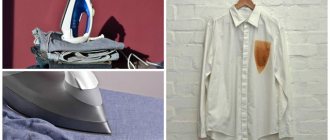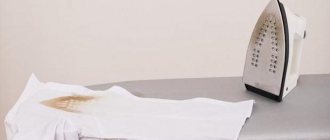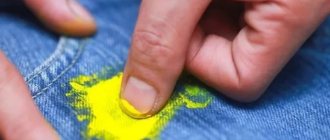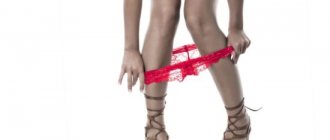A hook in a visible place gives even a new item a sloppy look, and can also turn into a hole or arrow. Fortunately, removing puffs from clothes is quick and easy. To do this, you only need a sewing needle and another 5 minutes of free time. The main thing is not to rush and follow the rules exactly. For dresses, trousers, and different types of fabrics, the technique for removing puffs is slightly different.
Where do the clues come from?
Tights appear on almost any thing, and this happens for various reasons.
- Wool and other natural materials are fabrics with soft threads. Over time, they wear out, causing puffs to form on clothing.
- Corners of furniture or heavy objects, protruding parts of fittings, poorly tightened screws or nails that are not driven in completely are the most common reasons for the appearance of puffs in clothes.
- Sometimes such unpleasant defects are formed due to cat or dog claws.
- Improper care: failure to follow the washing and drying regime, improper ironing is another reason that can lead to the formation of puffs. In addition, washing in a machine without using a reliable conditioner is a sure way to cause defects in things.
Installation steps
Regardless of the design option, how to hang a cornice on plasterboard or on a concrete ceiling, the stages of work will be as follows:
- Dismantling the old structure.
- Caulking or sealing unnecessary holes after dismantling. Under no circumstances use old holes for new fastenings, as... the entire structure may subsequently collapse.
- Measuring the length of the slopes from one edge of the window to the other to calculate how much the new structure will protrude on each side of the window opening. The future round curtain with rings should be longer than the width of the window covered with curtains and protrude symmetrically on each side of the window by at least 15-20 cm. In the case where the curtain has a design with hooks, this point with the indentation norm does not play a role.
- Assembling the cornice on the floor, determining its length.
- Drawing a marker using a tape measure and a building level to mark the future mounting location on the wall or ceiling. You need to draw with a marker carefully so that, if necessary, the marks made can be removed without leaving a mark on the surface of the wallpaper or ceiling. For the convenience of performing this manipulation, it is advisable to involve an assistant who will control the evenness of the line.
- Drilling holes according to the markings, into which the curtain will then be fixed to the dowels. If there is an error when drilling a hole, smaller dowels can be driven into it with gentle blows of a hammer.
- Fixing the device with dowels or screws.
How to remove strings on chiffon
Chiffon is a beautiful, but not the most practical fabric, which often causes snags. To remove them, you need to prepare a thin needle with a wide eye. Thread a thread through the eyelet so that it is double.
The needle is carefully threaded through the puff, and then the thread is pulled so that one of its tails passes through the loop and the other remains outside. The ends of the thread are tied in a knot. With a needle you need to pierce the fabric as close as possible to the place of tightening, best of all - into the loop from which it was formed.
Using a thread with a knot, carefully pull the puff to the wrong side. The fabric should not be stretched, as this may cause a hole to appear.
Thoroughly steam the repaired item with an iron in steam mode or through a damp cloth.
Removing pills from fabrics
Another defect accompanying puffs that forms on the surface of the dress is lint intertwined into a small ball. Knitted and synthetic fabrics are prone to this phenomenon. The pellets do not affect the strength of the material, but they spoil the beauty of the clothing: it gives the impression that the dress has been worn for a long time.
To remove formations from lint, small brushes with a sticky roller inside are made, which are sold in a sewing supply store. The mechanism is simple to use:
- lay out the dress on the table;
- run the machine from the top of the clothing to the bottom and back;
- repeat the procedure until all the pellets disappear.
To remove strands of lint from large knitted items, this method is not needed: the strands are simply cut off with nail scissors. Another source of pellets is pet hair.
A mechanical brush will also cope with them, but periodically the mechanism must be cleaned of the fibers accumulated inside. Regular washing will not get rid of puffs and pills.
How to remove puffs on tights
Defects on thin tights or stockings occur very often, but they can be dealt with. The exception is very thin tights up to 40 D, on them traces of puffs are too noticeable.
The sequence of actions in this case is similar to repairing satin, chiffon, and silk. It is convenient to use not an ordinary sewing needle, but a surgical one: it is thinner, but with a larger eye, so it is easier to work with it.
If the loop on the tights is not only tightened, but also dropped, you can carefully pick it up, as if knitting it to the required height, and then bring the last loop inside out. It must be secured with a thin thread with a knot. For light-colored tights, needlewomen sometimes use long brown hair - it holds the material well and is almost invisible.
Scare away with smell
Cats do not like citrus fruit aromas and sweet floral scents. Place orange or tangerine peels on the windowsill or place sprigs of lavender there.
An alternative solution to the problem is to use an air freshener with a citrus or lavender scent. Spray it regularly on the curtains, then the strong smell, unpleasant for cats, will wean your pet for a long time from jumping and climbing on them.
Special aerosol cat repellents, which can be purchased at a pet store, can leave stains on fabric, so they are not always suitable for spraying curtains.
How to remove a snag on knitwear
If the problem on a knitted product is limited to just a hook, then the method described above with a thin needle will help save the situation. If the thread breaks and the loops begin to fall down, the defect is eliminated using a special knitted hook.
The track is darned from the bottom up, and the last loop is secured from the wrong side. Finally, the knitwear is ironed and steamed. This is required to hide the renovated area.
Care instructions
It is difficult to completely eliminate snags, damage to the dress and the formation of lint balls on it. But you can reduce the risks if you follow the advice of experienced housewives. Here are some recommendations on how to protect your dress from puffs and pilling:
- wash clothes made of delicate fabrics only on the modes intended for this;
- use special conditioners for rinsing clothes;
- use an antistatic agent: it prevents animal hairs from sticking to the dress;
- Do not cut the thread sticking out of the fabric - this may cause the formation of a hole at the site of the defect.
If it was not possible to protect your favorite item from tightening, and attempts to make repairs were unsuccessful, there is another opportunity to preserve the beauty of the dress. You can disguise the defect with appliqué, fur trim, or other decoration.
When the reasons for the formation of puffs and pilling on a dress are known, it is easier to maintain the original condition of the clothing. There are ways to eliminate an unexpected flaw; you can use the one that is more trustworthy.
How to remove puff from wool
Woolen knitted items are repaired in exactly the same way. If we are talking about clothes made from bouclé threads or products made with embossed knitting, then puffs and tracks from dropped loops can easily be eliminated even with a regular crochet hook. When there is no hook at hand, use a large needle.
If the hook is small, it is enough to pull it to the wrong side and iron it. If the thread that got caught and pulled out of the fabric breaks, you need to attach a thread of the same color to it, carefully pick up the dropped loops with a crochet hook, and knit the missing rows.
Is it possible to save your favorite item from puffs with your own hands?
Fixing problems with wool fabric is not difficult. The difficulty is the number of cases of snags. Much more often, such problems arise on natural materials.
If a loop is found on woolen fabric, you must:
- Hook the loop with a standard craft hook.
- Pull it to the wrong side.
- Smooth out the area where the snag occurs with force.
A torn or unraveling tie needs to be corrected in another way, using:
- hook;
- wool thread of the same color.
Removing stretch marks on silk is not easy, but it is possible at home. To do this you will need two items:
Using a sewing needle, it is recommended to pull the thread sticking out on the front side inside out. Using an iron with a gentle steam function, carefully iron the toe area. When performing work, you should remember that one careless movement or poorly adjusted temperature conditions can cause more damage to clothing.
On a satin dress, defects are almost impossible to disguise using improvised means. When repairing things at home, you need to remember that the purpose of the manipulations is to hide the consequences of awkward movements or careless washing from prying eyes. Correction is carried out in the same way as on chiffon or silk fabric.
To remove a puff from a dress made of thin knitwear, you need to spend money and buy a hook at a craft store that is designed to lift the loops. This model is characterized by the presence of a special lock designed to prevent the captured thread from accidentally slipping out. On this fabric, the hook is formed with a track and folds along the edges. This is a feature of knitwear.
How to repair damage?
- Spread the straightened material on a smooth surface.
- Hook the thread that has gotten into the loop.
- Pull the hook lightly.
- Straighten the path with your hands, while simultaneously making smoothing movements in different directions.
- Secure the remaining loop on the fabric using matching threads and a small needle.
The linen dress fits perfectly and is breathable. It is recommended to starch the breathable material before putting it on, because it wrinkles a lot. To rid the item of snags, it is necessary to carry out a standard procedure using a sewing needle and an iron with a non-stick ceramic sole equipped with a steam function.
If it is not difficult to remove the puff from most fabrics, it is enough to pull the thread to the wrong side, but it is not recommended to do this with tulle. Otherwise, a track will remain on it, which will spoil the entire appearance of the product.
You can restore tulle in the following way:
- Prepare a backlight in the form of a table lamp, a glass jar and a magnifying glass.
- Place the damaged area on the jar so that the tie is positioned above the neck.
- Secure the canvas so that it does not move. You can use a rubber band for this.
- Point the light source at the damage and hold the magnifying glass to it.
- Using the blunt end of a thin needle, pull the thread in the opposite direction, restoring the fabric pattern. The movement continues until the end of the track, to the very beginning of the puff.
You need to act carefully and slowly, trying not to break the thread. This is painstaking work that requires perseverance. However, ultimately it will be possible to restore the entire canvas.
You need to be guided by the pattern that is on the tulle. When the work is completed, the tulle is carefully ironed or passed over it with a steamer.
How to remove puffs on outerwear or thick fabrics
This can be done quite simply. You will need a needle with a large eye - its size should be such that the craftswoman can work comfortably. It is best to choose a medium-sized tool.
- Insert the needle next to the puff - the distance between the defect and the tool should be about one millimeter.
- Press the needle in so that the eye is level with the hook thread.
- Pull the loose thread through the eyelet.
- Bring the needle and hook inside out.
You cannot cut the tightening thread - this may cause a hole to form. It is better to take a thin thread of a similar color and secure it on the wrong side with a couple of hidden stitches.
If this has led to deformation of the thread on the outer knitted garment, the ends of the break must be brought to the wrong side. There they are connected with matching thread, after which the loop can be tightened. This must be done carefully so as not to spoil the canvas.
General rules
Any fabric is susceptible to tightening, but the fleecy and thinner the material, the more often this problem occurs. The loose weaving of the threads causes them to cling to different surfaces and “jump out” out.
There are two ways to remove a snag:
- bring the thread to the wrong side;
- press it into the fabric, releasing the tension on both sides.
It is better to solve the problem in a radical way, that is, thread the thread into the fabric.
If you simply move it to the wrong side, it is likely that it will return back when you try to relieve the tension. If you put all the threads in place, this will not happen. There is also a third way to deal with puffs - stretching the material. However, it is not suitable for all products. Most often it is used when working with dense synthetic fabrics.
General rules to follow:
- Prepare the necessary tools in advance: a thin sewing needle, threads of a suitable color, a crochet hook.
- If the loops are small, it is better to use a magnifying glass.
- You should not try to remove the puff by weight. In this position there is a risk of breaking the thread. Once the integrity is damaged, it will not be possible to straighten it.
- You can finally put the thread in place if you go over the item with an iron or steamer.
Advice from Mobile Tailor
- Do not try to test the strength of a thing by stretching it in different directions, as when removing small puffs
- Carefully remove the curtain from the curtain rod and the clothes from the hanger, wrap them with the damaged part inward to avoid further injury
- Take it to a repair shop
We constantly have to deal with the consequences of sharp claws, snags from rhinestones, and tightening from “sharp” fittings. The Mobile Tailor technicians are guaranteed to help with clothing repairs.
What not to do?
In order not to completely ruin the thing, you cannot do the following:
- You should not pull the fabric in different directions, trying to restore its integrity. This method of returning the loop to its place is dangerous because the entire weave may come apart.
- Do not try to cut or rip the thread. The tightening will continue.
- It is forbidden to wash a product with puffs. If the drum rotates vigorously, the damage will only worsen.
How to prevent puffiness
It is not possible to completely protect clothing or home textiles from snags, but you can minimize the risks. Various tips like “spray new tights with varnish” or “keep them in the freezer” are useless. It is better to follow simple rules that will extend the life of your clothes.
- You should not wash things too often, choose an intensive washing mode, high water temperature or spin at maximum speed. This leads to wear of the fibers and accelerates the formation of puffs.
- It is better to wash delicate items (tights, underwear, chiffon or silk dresses) in a special bag that will prevent the formation of puffs.
- Try to wash clothes on a delicate cycle, without wringing too hard.
- Fabric softeners will help extend the life of clothes and protect the fibers from wear.
If a tightening appears, but it is impossible to eliminate it, embroidery or applique at the site of the defect will help.
<< Back to Lifehacks Studio
Prevention
It is unlikely that it will be possible to completely protect clothing from snags. But you can minimize the risk of their occurrence.
Prevention of puffs is as follows:
- Wash things correctly. Before washing, check the label information. For delicate fabrics, use the appropriate washing machine cycle. It is better to wash especially delicate items by hand. You should also use soaking and aggressive chemicals to a minimum. Improper care will cause the fabric to wear out quickly and increase the risk of snagging.
- Handle wet clothes with care. When wet, the material becomes especially vulnerable. It is unacceptable to twist things too hard or dry them with an iron.
- Store delicate items and expensive clothes in a case. It happens that puffs appear right in the closet from other clothes. They can be left behind by locks, brooches, rhinestones. The cover will protect your things from adverse external influences.
- Use conditioner when washing. It creates a protective film that improves the wear resistance of the fibers. Having lost their integrity, “fluffy” threads cling much faster than strong and smooth ones.
Almost any kinks can be repaired. The larger the threads, the easier it is to do this. Usually repairs do not take much time. On synthetics, the hooks are stretched; on knitwear, they are removed with a hook or a needle. If you doubt your abilities, you can take the clothes to the studio. They undertake to correct even complex defects.











